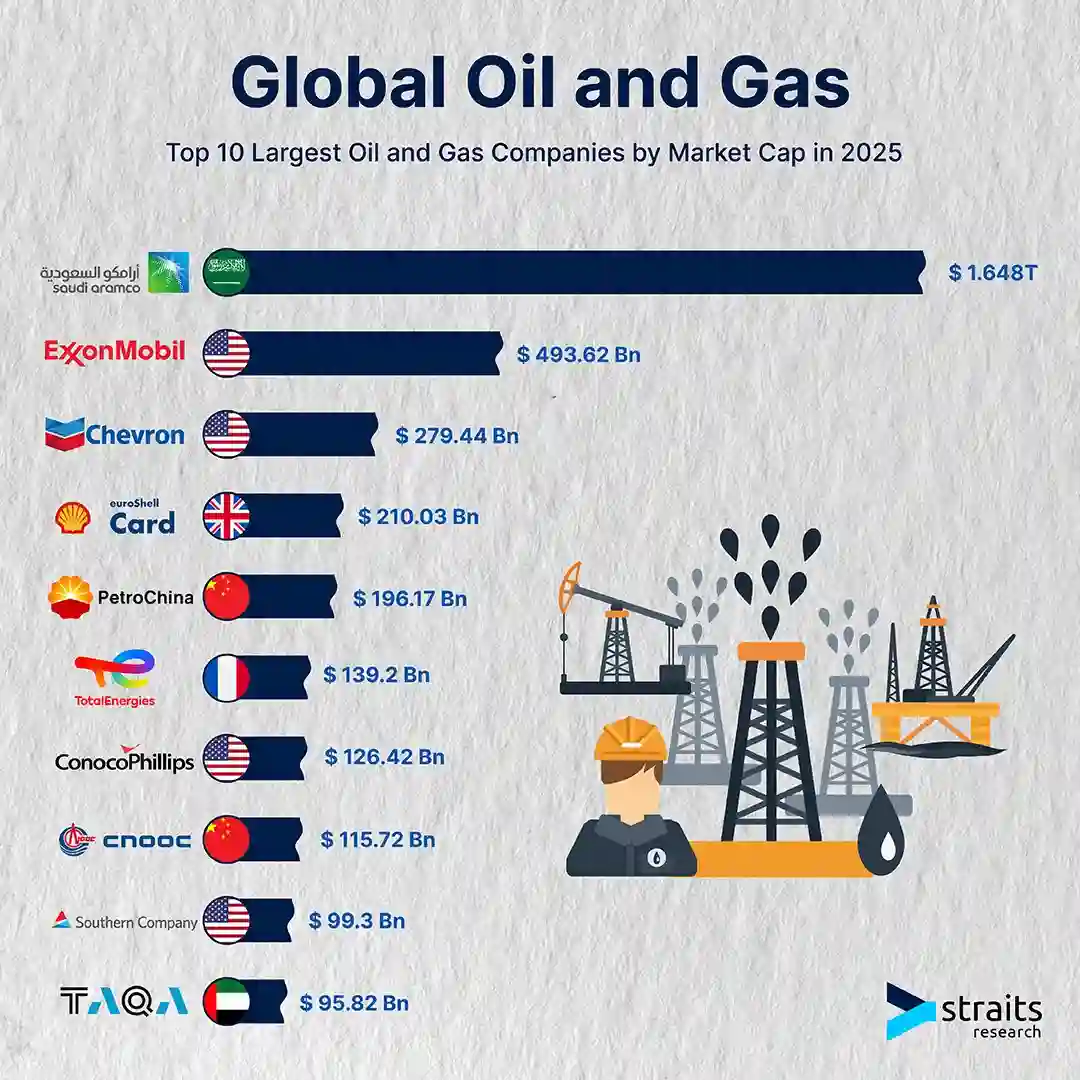Leading 10 Oil and Gas Companies by Market Cap in 2025

The oil and gas industry remains a cornerstone of the global economy, supplying energy for transportation, heating, electricity generation, and manufacturing. Despite the rise of renewable energy, oil and gas continue to drive economic growth, employment, and infrastructure development worldwide.
Top Companies
As of March 2025, Saudi Aramco stands as the world's largest oil and gas company, with a market capitalization of $1.648 trillion. Aramco is the biggest oil and gas corporation in the world. Aramco, which now produces about 9.2 million barrels per day (bpd), plans to adhere to voluntary OPEC+ production cutbacks through December 2025 to reach a maximum sustainable capacity of 12 million bpd. To achieve a sustainable sales gas rate of 2 billion standard cubic feet per day (Bcf/d) by 2025, the company is also increasing its gas output.
Saudi Arabia's Jafurah project operated by Saudi Aramco, the country's largest unconventional gas site, is set to begin production in Q3 2025, with an eventual capacity of 3.15 Bcf/d by 2028. In 2024, the country's natural gas output was 123 billion cubic meters, in 2025, it is expected to drop to 121 billion cubic meters. The projected 229 trillion standard cubic feet of raw gas and 75 billion stock tank barrels of condensate from the Jafurah field are part of the enormous hydrocarbon reserve base that Aramco still manages, which amounts to 250 billion barrels of oil equivalent.
ExxonMobil ranks second with a market capitalization of $493.62 billion, having achieved record net production of 4.3 million barrels of oil equivalent per day (BOE/d) by the end of 2024. With a focus on the Permian Basin, Guyana, and LNG projects in Asia-Pacific, Australia, and West Africa, this company wants to increase output to 5.4 million BOE/d by 2030. With significant investments in carbon capture systems and low-emission programs, its natural gas output is anticipated to reach 7.7 billion cubic feet daily by 2025, with an annual target of 6.7 MTA CO2 capture.
Chevron follows with a market cap of $279.44 billion, predicting a 6-8% growth in output in 2025, mostly due to a 10% increase in the Permian Basin and more than 1 million BOE/d from Kazakhstan. By the end of 2025, the continuous growth of the Mediterranean's Leviathan field is expected to reach a daily production of 1.4 billion cubic feet.
With a $210.03 billion market value, Shell anticipates about 500,000 BOE/d from projects that are started between 2023 and 2025. Its natural gas supply chain processes up to 24.3 Bcf per day, and its UK production surpasses 100,000 barrels per day. Producing 2.5 million barrels of oil per day and recording 4.9 trillion cubic feet of natural gas output in 2023, PetroChina, which ranks fifth with a market valuation of $196.17 billion, aims to reach 50 billion cubic meters by 2025. To achieve near-zero emissions by 2050, the company is also expanding its capacity for renewable energy.
TotalEnergies, valued at $139.20 billion, targets a 3% annual oil and gas production growth by 2030, with LNG sales expected to reach 50 Mt/year. While maintaining steady fossil fuel production for the next 20 years, the company intends to increase the capacity for renewable energy. With a $126.42 billion market capitalization, ConocoPhillips anticipates 2.34 to 2.38 million BOE/d in 2025, boosted by its acquisition of Marathon Oil. Focusing on deepwater exploration and carbon capture projects, CNOOC, which is placed tenth with $115.72 billion, aims to produce more than 2 million BOE/d and more than 29 billion cubic meters of natural gas.
Southern Company, primarily an electric utility, holds the ninth position with a market cap of $99.30 billion and a natural gas throughput volume of 822 billion cubic feet. The U.S. Energy Information Administration projects U.S. natural gas production to rise to 105.2 Bcf/d in 2025, reflecting growing domestic demand. Moreover, TAQA from the UAE ranks tenth at $95.82 billion, investing in gas projects in Egypt and Mauritania as part of its 2030 strategy.
Oil and gas companies continue to dominate the energy sector despite the global energy shift by making strategic investments in alternative energy sources, sustainability, and production expansion. These companies remain critical to economic stability, energy security, and industrial growth worldwide.




